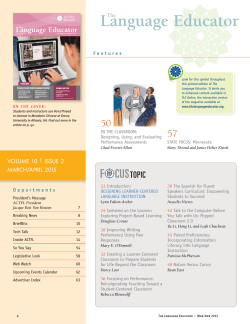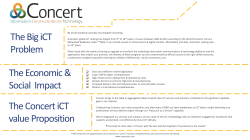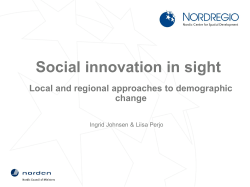
PROJECT-BASED LEARNING THROUGH APPLIANCE OF ICT IN
PROJECT-BASED LEARNING THROUGH APPLIANCE OF ICT IN THE TEACHING Assoc. Professor PhD Snezana Mirascieva, Pedagogical faculty University”Goce Delcev” Stip, Macedonia snezana.mirascieva@ugd.edu.mk Introduction The technological development is a specific mark of the advantages of one community. In other words, the society transforms in many areas upon the influence of the expansive technological development. One of the most attractive fields for the technology is the education regarding its possibilities for a higher level of individualization. In that sense, we can freely talk about the explosion of technology in the classroom. From the other side, this situation implies the problem linked with the theory and practice. Namely, the world changes and the students need such knowledge and abilities that allow them successful inclusion in the community life. This need is implied by the society and it is directed towards adjustment of the education to the changing world. While trying to respond to the requests by the society, many questions appear referring to the changes of the organization of teaching and including new strategies of teaching and instructing. One of those strategies is learning through projects. The purpose of this strategy is creation of a new teaching practice which will reflect the environment where the students live and learn. Project-based learning in the teaching Project-based learning is not a new educational technique; since the 16th century, it has been an established method for training architectural and engineering students in Europe. Its roots can be found in the John Dewey’s teaching. Namely, learning through projects as a teaching concept according to Dewey aims at preparing the student for life “through the life”. The teaching as a process of learning and instructing is organized according to the model project-method which moves through the following phases: defining the problem, assigning a task, elaborating a project (defining the hypothesis), collecting data according to the determined plan, making conclusions (accepting or dismissing the hypothesis) and practice. But, in the 21st century, project-based learning is at the centre of a global shift in education, from the traditional focus on teacher-led instruction to a new focus on the self-directed learner. So, the today’s students will enter a workforce that is vastly different from that of their parents. Increasingly, they must be able to: work in teams that are cross-functional and often global to solve complex and important problems that critically affect the world while responding creatively to rapidly changing business landscapes using rapidly evolving technologies. In that sense, project-based learning is a systematic teaching and learning model that engages students in learning knowledge and skills from a series of complex tasks including: design and planning, problem solving, decision making, product and artefact creation, and the communication of results. Why is the learning through projects needed, or what its didactical values are? Project-based learning refers to the use of classroom projects, intended to bring about profound learning, where students use technology and inquiry to engage with issues and questions that are relevant to their lives. These classroom projects are used to assess student's subject matter competence compared to traditional testing. Project-based learning can be best defined as instruction relating questions and technologies which refer to the student everyday lives to classroom projects. Students form their own researches of their own group which allows students to develop valuable research skills. The students are involved in design, problem solving, decision making, and research activities. It allows students to work in groups or on their own, allowing them to come up with ideas and realistic solutions or presentations. Students take a problem and apply it to a real life situation with these projects. On the other side, project -based learning provides complex tasks based on challenging questions or problems that involve the students' problem solving, decision making, research skills, and reflection that include teacher facilitation, but not direction. Project-based learning is focused on questions that drive students to encounter the central concepts and principles of the primary principles of the subject. With project-based learning students learn from these experiences and take them into account and apply them to their lives in the real world. Project-based learning is a different teaching technique that promotes and practices new learning habits. The students have to think in original ways to come up with the solutions to these real world problems. It helps with their creative thinking skills by showing that there are many ways. So project-based learning contributes for: a) Critical Thinking. Project-based learning is not just about memorizing facts. It’s about students applying what they learn to solve a complex problem. Students are involved in an active inquiry, exploring an issue from multiple perspectives, learning how to ask pertinent questions, collecting relevant information, and synthesizing a solution. Studies show that well-designed learning projects can lead to a profound understanding of the subject matter and contribute to those students who think more like experts in their field of study. b) Teamwork. Project-based learning typically involves teamwork. Welldesigned learning projects help students become effective collaborators, contributors, and leaders, developing such skills as listening, questioning, and compromising to achieve a common goal. In addition, sharing and discussing their ideas help students build deep knowledge and become members of a “community of practice,” in which participants work together to continuously advance their understanding. c) Creativity. In the project-based learning, students often work on an authentic, real-world problem that does not lead to one correct answer. Students must be creative in coming up with new ideas, combining knowledge and skills across disciplines, and designing innovative solutions that meet a real need. d) Cross-Cultural Understanding. Some project teams bring together participants from different parts of the world or with different backgrounds, increasing student awareness of cultural differences and building respect for different perspectives. When students work with partners who are different from themselves, they learn how to resolve misunderstandings and overcome cultural and language barriers. e) Communication. In project-based learning, students create products that communicate their ideas and learning to others. They often present their work, sometimes to an authentic audience such as the community or a client. Through this process, students learn important skills such as how to display findings and recommendations, how to organize a presentation, and how to capture and maintain audience interest. In addition, presenting their work to a broader audience often motivates students to produce higher quality products. f) Technology. Through technology-supported projects, students learn how to use ICT tools in context. Technology also supports deep student learning by helping them access real-world data, collaborate at a distance, visualize and analyze data, and create multimedia presentations of their results. g) Self-Direction. Project-based learning puts students in the driver’s seat, giving them more control over their learning. In well-designed learning projects, teachers skilfully design and guide—but do not fully direct— students’ learning. Students formulate their own problems and goals, plan the steps of the project, seek the resources they need, and design their own products. Research has shown that students learn better and gain more selfconfidence when they feel a sense of ownership over their learning process. ICT in teaching and project-based learning In the following text we will explain the project-based learning with ICT in teaching, particularly through using of the web quest technique. At the beginning we can try to give an answer on the question what an ICT is and why the web quest strategy? Different approaches are found when trying to determine the concept of ICT. We have accepted the approach according to which ICT represents a unity of means, procedures and methods for information flow and exchange. This approach clearly contains the intentions to apply progressive techniques and procedures for independent acquisition of new knowledge, greater quality and persistence of gained knowledge. In this context web quest represents a teaching and learning strategy with the application of ICT. The structure of this strategy contains the following components: introduction, task process, resources and evaluation. [3] The introductory part plays an important role as it introduces students into the topic through questions and problems. It has a dual aim: a motivating one and a cognitive one. The introduction is useful if it orients students towards the task in an appropriate manner, and if it arouses their interest. The second component is the task. In this phase it is necessary to determine which task should be done by the students and what is expected from them, i.e. to determine the cognitive level of the assignment. In the second phase marked as a process we determine and establish each step that must be taken in order to fulfill the task, i.e. the process is a step-by-step description of how students will accomplish the task. During this we need to establish the clarity and the phases, and we need to enrich the process activities, which is the basic characteristic of this phase. The component recourses are related to the relevant sources of knowledge-books and other off-line resources that can be and need to be used for task solving. Here we should not exclude the importance of the quality and quantity of sources. Evaluation is realized upon clearly determined criteria. These criteria comprise qualitative and quantitative descriptors. Knowledge and skills for task solving are clearly measured with the instrument for evaluation. As it can be seen, web quest learning strategy initiates independence, persistence, accuracy, critical thinking and creativeness in children. That is why this strategy is interesting and appealing. As it can be noted, the web quest strategy with its structure and didactic values fully correlates to the basics and intentions of the learning through projects. Namely, in a relation of the organizational basics, the project-based learning and web quest technique start with the preparatory phase, through the operational one, and end with the verification phase. The usage of the web quest technique enriches the source of resources for collecting data in the operational phase thus making the project-based learning more efficient, and the learning more qualitative. In a relation to the didactic values, both the project-based learning and the web quest technique in the teaching are realized through the technological support, and contribute to the development of the critical thinking, the creativity and the creations. On this way the student turns into an active subject, s/he discovers new knowledge and becomes a constructor of the selfknowledge. Conclusion In project-based learning, students discover the meaning of what they learn by working together to solve complex, real-world problems, rather than being taught facts from books. A growing body of evidence indicates that project learning supports the development of critical skills students must have to meet the demands of the 21st century. At the same time, consensus is growing among scholars and educators that project-based learning is one of the most promising vehicles for promoting 21st century skills in the classroom. The linking chain between the project-based learning and ICT in teaching by web-quest technique contains the primary aim of the teaching- effective learning, quality knowledge and full development of the personality of the student towards building a person who can face the challenges and needs of the life and work of the 21st century. References: Thomas,W.J.(2000) A review of www.coe.tamu.edu -13.01.2010 research on Project-based learning, www. webquest.org www.pbl-online.org www.bie.org/about/what is pbl www.thinkquest.org/promotion/white_papers www. reflectineducation.net/index.php/reflecting/article
© Copyright 2025











